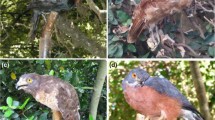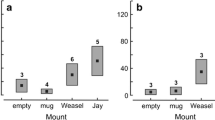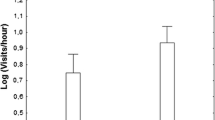Abstract
Nest predation accounts for the majority of nesting failure, and hence there has been strong selection on behaviour to reduce nest predation, including patterns of nest defence. Here, we test risk-taking behaviour to experimentally placed predators in the presence or absence of nestlings. We use the superb fairy-wren (Malurus cyaneus) to test the prediction that vigilance will be comparable with and without nestlings, but that alarm vocalisations will increase when nestlings are present. We found support for both predictions. Adult vigilance of predators was comparable with and without nestlings. Alarm vocalisation intensity was predicted by predator type and nestling presence, and was highest to the snake model in the presence of nestlings. These results point to selection for differentiated nest defence response in relation to predator type and the presence or absence of nestlings.



Similar content being viewed by others
References
Arnold KE (2000) Group mobbing behaviour and nest defence in a cooperatively breeding australian bird. Ethology 106:385–393
Bayly KL, Blumstein DT (2001) Pied Currawongs and the decline of native birds. Emu 101:199–204
Bradbury JW, Vehrencamp SL (1998) Principles of animal communication. Sinauer, Sunderland
Bradley E, Bradley J (1958) Notes on the behaviour and plumage of colour-ringed Blue wrens. Emu 58:313–326
Caro T (2005) Antipredator defenses in birds and mammals. Chicago University Press, Chicago
Charif RA, Waack AM, Strickman LM (2008) Raven Pro 1.3 user’s manual. Cornell Laboratory of Ornithology, Ithaca
Cheney DL, Seyfarth RM (1985) Vervet monkey alarm calls: manipulation through shared information? Behaviour 93:150–166
Clark RW (2005) Pursuit-deterrent communication between prey animals and timber rattlesnakes (Crotalus horridus): the response of snakes to harassment displays. Behav Ecol Sociobiol 59:258–261
Cockburn A, Osmond HL, Mulder RA, Green DJ, Double MC (2003) Divorce, dispersal and incest avoidance in the cooperatively breeding Superb Fairy-wren Malurus cyaneus. J Anim Ecol 72:189–202
Colombelli-Négrel D (2008) The evolution of anti-predator responses and vocal communication in superb fairy-wrens (Malurus cyaneus). PhD thesis. Flinders University, Adelaide
Colombelli-Négrel D, Kleindorfer S (2009) Nest height, nest concealment, and predator type predict nest predation in superb fairy-wrens (Malurus cyaneus). Ecol Res 24:921–928
Colombelli-Négrel D, Robertson J, Kleindorfer S (2009) A new audio-visual technique for effectively monitoring nest predation and the behaviour of nesting birds. Emu 109:83–88
Cresswell W (1994a) The function of alarm calls in redshanks, Tringa totanus. Anim Behav 47:736–738
Cresswell W (1994b) Song as a pursuit-deterrence signal and its occurrence relative to other antipredator behaviors of the skylark on attack by merlins. Behav Ecol Sociobiol 34:217–223
Curio E, Regelman K (1985) The behavioural dynamics of Great Tits (Parus major) approaching a predator. Z Tierpsychol 69:3–18
Evans CS (1997) Referential signals. Persp Ethology 12:99–143
Evans CS, Evans L, Marler P (1993) On the meaning of alarm calls: functional reference in an avian vocal system. Anim Behav 43:23–38
Gluck E (1987) An experimental study of feeding, vigilance and predator avoidance in a single bird. Oecologia 71:268–272
Haftorn S (2000) Contexts and possible functions of alarm calling in the Willow Tit, Parus Montanus; the principle of ‘better safe than sorry’. Behaviour 137:437–449
Hasson O (1991) Pursuit-deterrent signals: communication between prey and predator. Trends Ecol Evol 6:325–329
Higgins PJ, Peter JM, Steele WK (2001) Handbook of Australian, New Zealand and Antarctic birds. Volume Five—tyrant-flycatchers to chats. Oxford University Press, Melbourne
Hurlbert SH (1984) Pseudoreplication and the design of ecological field experiments. Ecol Monogr 54:187–211
Kleindorfer S, Hoi H, Fessl B (1996) Alarm calls and chick reactions in the moustached warbler (Acrocephalus melanopogon). Anim Behav 51:1199–1206
Kleindorfer S, Hoi H, Ille R (1997) Nestling growth patterns and antipredator responses: a comparison between four Acrocephalus warblers. Biologia 52:677–685
Kleindorfer S, Fessl B, Hoi H (2003) The role of nest site cover for parental nest defence and fledging success in two Acrocephalus warblers. Avian Science 3:21–29
Kleindorfer S, Fessl B, Hoi H (2005) Avian nest defence behaviour: assessment in relation to predator distance and type, and nest height. Anim Behav 69:307–313
Krams I, Krama T, Igaune K (2006) Alarm calls of wintering great tits Parus major: warning of mate, reciprocal altruism or a message to the predator? J Avian Biol 37:131–136
Leavesley AJ, Magrath RD (2005) Communicating about danger: urgency alarm calling in a bird. Anim Behav 70:365–373
Macdonald DW, Sillero-Zubiri C (2004) Biology and conservation of wild canids. Oxford University Press, Oxford
Magrath RD, Platzen D, Kondo J (2006) From nestling calls to fledgling silence: adaptative timing of change in response to aerial alarm calls. Proc R Soc B 273:2335–2341
Magrath RD, Pitcher BJ, Gardner JL (2007) A mutual understanding? Interspecific responses by birds to each other's aerial alarm calls. Behav Ecol 18:944–951
Manser MB (2001) The acoustic structure of suricates' alarm calls varies with predator type and the level of response urgency. Proc R Soc Lond B 268:2315–2324
Marler P, Evans C (1996) Bird calls: just emotional displays or something more? Ibis 138:26–33
Martin TE (1992) Interaction of nest predation and food limitation in reproductive strategies. Curr Ornithol 9:163–197
Martin TE (1995) Avian life history evolution in relation to nest sites, nest predation, and food. Ecol Monogr 65:101–127
Maynard Smith J (1965) The evolution of alarm calls. Am Nat 99:59–63
McGregor PK (2000) Playback experiments: design and analysis. Acta Ethologica 3:3–8
McLean IG, Smith JNM, Stewart KG (1986) Mobbing behaviour, nest exposure and breeding success in the American robin. Behaviour 96:171–186
Møller AP (1988) False alarm calls as a means of resource usurpation in the great tit Parus major. Ethology 79:25–30
Montgomerie RD, Weatherhead PJ (1988) Risks and rewards of nest defence by parent birds. Q Rev Biol 63:167–187
Mulder RA (1995) Natal and breeding dispersal in a cooperative, extra-group-mating bird. J Avian Biol 26:234–240
Mulder RA (1997) Extra-group courtship displays and other reproductive tactics of superb fairy-wren. Aust J Zool 45:131–143
Pietz PJ, Granfors DA (2000) Identifying predators and fates of grassland passerine nests using miniature video cameras. J Wildl Manage 64:71–87
Redondo T (1989) Avian nest defence: theoretical models and evidence. Behaviour 111:161–195
Ricklefs RE (1969) An analysis of nesting mortality in birds. Contrib Zool 9:1–48
Ricklefs RE (1977) On the evolution of reproductive strategies in birds: reproductive effort. Am Nat 111:453–478
Robinson SR (1980) Antipredator behaviour and predator recognition in Belding’s ground squirrels. Anim Behav 28:840–852
Robinson WD, Rompré G, Robinson TR (2005) Videography of panama bird nests shows snakes are principal predators. Ornitologia Neotropical 16:187–195
Roff D (1992) The evolution of life histories: theory and analysis. Chapman and Hall, New York
Rosenthal R (1987) Judgement studies. Design, analysis, and meta-analysis. Cambridge University Press, Cambridge
Rosenthal R, Rosnow RL (1985) Contrast analysis: focused comparisons in the analysis of variance. Cambridge University Press, Cambridge
Rosenthal R, Rosnow RL, Rubin DB (2000) Contrasts and effect sizes in behavioral research. Cambridge University Press, Cambridge
Rowley I, Russell E (1997) Fairy-wrens and Grasswrens (Maluridae). Oxford University Press Inc, New York
Schaefer T (2004) Video monitoring of shrub-nests reveals nest predators. Bird Study 51:170–177
Seyfarth RM, Cheney DL (1990) The assessment by vervet monkeys of their own and another species' alarm calls. Anim Behav 40:754–764
Seyfarth RM, Cheney DL, Marler P (1980a) Vervet monkey alarm calls: semantic communication in a free-ranging primate. Anim Behav 28:1070–1094
Seyfarth RM, Cheney DL, Marler P (1980b) Monkey responses to three different alarm calls: evidence of predator classification and semantic communication. Science 210:801–803
Sherman PW (1985) Alarm calls of Belding's ground squirrels to aerial predators: nepotism or self-preservation? Behav Ecol Sociobiol 17:313–323
Snedecor GW, Cochran WG (1967) Statistical methods, 6th edn. Iowa State University Press, Iowa
Stake MM, Cimprich DA (2003) Using video to monitor predation at Black-capped Vireo nests. Condor 105:348–357
Stearns S (1992) The evolution of life histories. Oxford University Press, Oxford
Swaisgood RR, Owings DH, Rowe MP (1999) Conflict and assessment in predator-prey system: ground squirrels versus rattlesnakes. Anim Behav 57:1033–1044
Templeton CN, Greene E, Davis K (2005) Allometry of alarm calls: black-capped chickadees encode information about predator size. Science 308:1934–1937
Thomspon FR III, Burhans DE (2004) Differences in predators of artificial and real songbird nests. evidence of bias in artificial nest studies. Cons Biol 18:373–380
Thomspon FR III, Dijak W, Burhans DE (1999) Video identification of predators at songbird nests in old fields. Auk 116:259–264
Tidemann SC (1986) Breeding in three species of fairy-wrens (Malurus): do helpers really help? Emu 86:131–138
Trivers R (1972) Sexual selection and parental investment. In: Campbell B (ed) Sexual selection and the descent of man 1871–1971. Aldine, Chicago, pp 136–179
Weatherhead PJ, Blouin-Demers G (2004) Understanding avian nest predation: why ornithologists should study snakes. J Avian Biol 35:185–190
Yasukawa K, Cockburn A (2009) Antipredator vigilance in cooperatively breeding superb fairy-wrens. Auk 126:147–154
Acknowledgements
We thank the Australian Research Council, Department for Environment and Heritage, Sir Mark Mitchell Foundation, Nature Foundation SA Inc, the Holsworth Foundation, and the Biological Society of South Australia for financial support. We thank Dr. Philippa Horton at the South Australia Museum, Adelaide, for the loan of mounted currawong, and Dr. Chris Evans at the Centre for the Integrative Study of Animal Behaviour, Macquarie University, for the loan of the mounted fox.
Author information
Authors and Affiliations
Corresponding author
Rights and permissions
About this article
Cite this article
Colombelli-Négrel, D., Robertson, J. & Kleindorfer, S. Nestling presence affects the anti-predator response of adult superb fairy-wrens (Malurus cyaneus). acta ethol 13, 69–74 (2010). https://doi.org/10.1007/s10211-010-0072-7
Received:
Revised:
Accepted:
Published:
Issue Date:
DOI: https://doi.org/10.1007/s10211-010-0072-7




